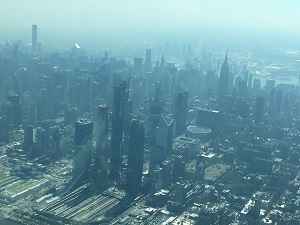Reducing Pollution through NAAQS and Geothermal Heating - Air Mail!
The New York State Department of Environmental Conservation sent this bulletin on 11/19/2021 01:38 PM EST |
| DEC Delivers - Information to keep you connected and informed from the NYS Department of Environmental Conservation |
| Share or view as a web page || Update preferences or unsubscribe |
This Month's Topics: |
Public & Stakeholder Participation Information
Air Mail! is the publication to announce public and stakeholder information about air quality topics. All NYS residents are environmental stakeholders – we welcome anyone to join the information sessions and other opportunities posted here. Heating & Cooling with the Power of the EarthThe temperature just a few feet below the earth’s surface remains relatively constant, even during hot summer days and bitter cold winter nights. Geothermal technology systems (a.k.a. ground source heat pumps) harness this naturally stable underground temperature and use it to heat and cool buildings. Many looking to save money and green up their heating and cooling systems utilize geothermal technology in their homes. Installing a ground source heat pump requires some digging or drilling outside of the building. Pipes are placed underground and filled with water to transfer heat to and from the building. A pump then circulates the water back and forth between the ground and the building to move the heat. When the building's temperature dips below the thermostat settings, the heat pump moves the warmer water from underground into the building, compresses the water to generate more heat, and releases that heat inside the building. When the building is too warm, the heat pump reverses the process by bringing in the cooler underground temperatures, expanding it for additional cooling, and releasing the cooled air inside the building. Since the movement of heat between the pipes and their surroundings is a natural process, energy is only used to power the water pumps, compressors, and fans inside the heat pump unit inside the building. As a result, ground source heat pumps significantly reduce the amount of energy needed to heat and cool a building. According to the New York State Energy Research and Development Authority, ground source heat pumps can return 3 to 4 times the initially supplied energy through heating or cooling. In a residential setting, that can mean huge savings on bills as well as significantly reduced emissions. In addition, ground source heat pumps usually last longer and require less maintenance than traditional heating systems. To learn more about ground source heat pumps and their benefits, visit NYS Clean Heat. Graphic Caption: Ground source heat pumps eliminate the need to burn home heating fuels and reduce the overall energy demand and emissions. Graphic Credit: United States Environmental Protection Agency Air Pollution Basics: NAAQSWhenever the topic of air pollution regulation arises, National Ambient Air Quality Standards (NAAQS) are bound to come up. But what are they? NAAQS are a group of air pollution reduction goals applied to the entire US, set by the Environmental Protection Agency (EPA). The Clean Air Act requires EPA to establish, review, and revise standards for the six harmful criteria pollutants laid out in the NAAQS, including ground-level ozone, particulate matter, carbon monoxide, lead, sulfur oxides, and nitrogen oxides. These criteria pollutants are found across the country and can harm human health and the environment, if not kept in check. NAAQS fall into two main categories: primary and secondary standards. Primary standards aim to protect human health, including those most at risk (children, the elderly, and people with preexisting conditions). Secondary standards provide public welfare protection by covering non-health-related adverse effects of air pollution, including reduced visibility and damage to buildings and the environment. These standards are regularly reviewed and adjusted by EPA based on current research for each pollutant. The Clean Air Scientific Advisory Committee provides input to EPA to ensure NAAQS levels are based on accurate data and remain up-to-date with current air quality conditions and research. When it comes to enforcing NAAQS in states across the US, State Implementation Plans (SIPs) play a crucial role. SIPs are a collection of regulations and programs used to enforce and maintain the Clean Air Act within each state. These regulations help keep our air clean by targeting the specific areas of a state that need to lower criteria pollutant levels to comply with NAAQS. Overall, NAAQS are a vital part of the Clean Air Act’s multi-layered approach to safeguarding air quality across the country and in NYS. The DEC website has more information about NYS’ SIPs and ways you can help reduce pollution to keep our air clean. Photo Caption: An aerial view of Manhattan, taken from a LISTOS research plane in 2018, showing ground level ozone in the air. Over the years, regulations such as NAAQS have significantly reduced air pollutant emissions, leading to fewer air quality alerts, clearer views, and cleaner air overall. Photo Credit: Xinrong Ren, LISTOS researcher Get There Green! Results
Helpful Links
Dates to Remember
Stay Informed about Your Air QualityNYS' ozone season runs from April through September. DEC publishes ground-level ozone forecasts during ozone season and particulate matter pollution forecasts year-round using a scale called the Air Quality Index (AQI). DEC sends out an air quality alert when there is a high AQI value, which indicates polluted air. Individuals with pre-existing respiratory or cardiovascular conditions, and people who exercise outdoors should take caution during an air quality alert. Find out if an Air Quality Alert is in effect by calling the toll-free Ozone Hotline: 1-800-535-1345. The AQI can be accessed in three ways:
Connect with us at Air Mail!Did you enjoy reading this issue? Perhaps your friends and family would too. Share Air Mail! by using the “Share” button below. If you would like to receive Air Mail! in your own email box, sign up now! We would also like to know what you think. Send your Air Mail! questions and comments to the team at DAR.web@dec.ny.gov. |




 From September 20 through 26, NYS celebrated
From September 20 through 26, NYS celebrated